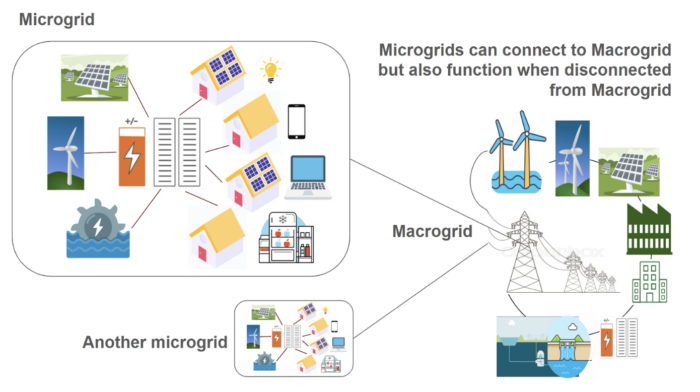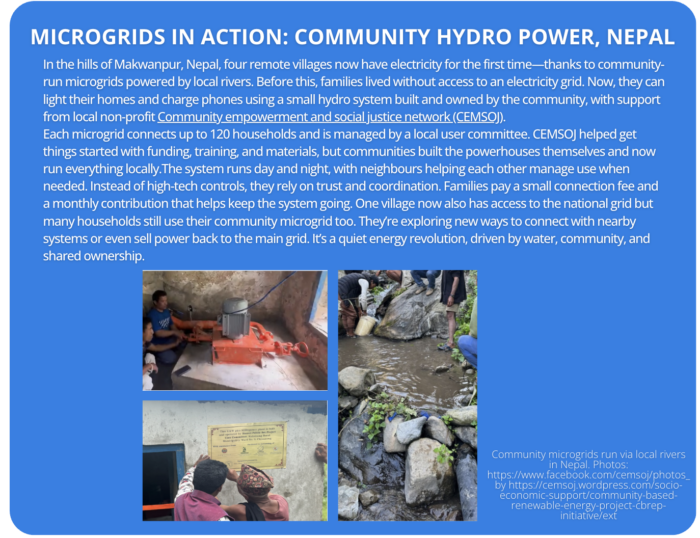This is a guest blog by Elaine Baker, member of the Community Energy Federation of Ireland and 350’s Our Own Power Network.
Worldwide, communities are showing the way by creating resilient, efficient and affordable local renewable energy projects. This is energy justice in action: taking power, literally and politically, back into the hands of ordinary people. Microgrids are one of the most effective tools in this shift, allowing communities, especially those historically excluded, to take ownership of their energy future.
What are grids and what role do they play in energy generation?
Electricity grids are networks* that carry power from where it’s made — like solar farms or wind turbines — to homes, schools, health facilities and businesses. They’re important because they make sure everyone gets the energy they need, when they need it.
There are three main ways of accessing electricity:
- Macrogrids: large national or regional grids
- Microgrids: community-scale networks
- Off-grid systems: individual setups like solar kits for one home

What is a microgrid?
A microgrid is a small electricity network that links multiple homes and premises together through wires. It has its own electricity generation facilities, energy storage and appliances. A microgrid can operate as an “island”, running independently, or it can connect to the main grid. Unlike a regular part of the national grid, a microgrid can function independently, giving communities control over how power is produced, shared, and used.

Illustration of microgrids, each with their own renewable generation and batteries, which can each function independently from the macrogrid, or connect to a macrogrid. If the microgrid connects to the macrogrid, it allows microgrids to share energy with each other, and access resources such as large scale pumped hydro energy storage and off-shore wind farms. If the macrogrid goes down, the microgrid still works on its own.
How can communities benefit from a microgrid?
Community energy can include different types of projects, run by local governments and communities. Renewable energy projects often involve solar panels or wind turbines, linked to homes, community buildings, or the national grid. However, microgrids offer communities a way to not only generate their own renewable energy, but also own and manage their own electricity networks, including the wires and the infrastructure that distribute power. Microgrids are good for communities because they:
- Expand energy access in off-grid areas: In places where a macrogrid has not yet reached, including many rural areas in the Global South, microgrids provide a way to build electricity systems from the ground up. As the macro grid expands, these microgrids can connect and exchange electricity with other microgrids or with larger centrally operated renewable energy generation and storage facilities, as needed.
- Facilitate sharing of electricity: Of course, each household and business could invest in its own stand-alone solar panels and batteries. But sharing electricity through a microgrid is often more efficient. Homes without panels or suitable rooftops can still access clean energy, and the community as a whole can invest in fewer batteries — reducing environmental impacts — by sharing storage, and balancing use across the grid.
- Strengthen community control even in grid-connected areas: Even where a macrogrid exists, new developments, like a new community centre, business park or an apartment block, can benefit from creating a microgrid. It’s often easier (and cheaper) for the macrogrid to connect one new microgrid rather than hooking up to each new home or premises individually.
- Make communities resilient: When the main grid goes down, microgrids can keep running independently. Unlike many grid-connected households today, which lose power even if they have solar panels, microgrids can continue operating during blackouts on the main grid.
- Allow local ownership and control: Communities can set fair tariffs, plan new renewable projects, decide how to connect with the macrogrid, and raise funds collectively.
Who owns grids now?
National scale or macrogrids are usually publicly owned and run by government entities, and rightly so. Grids are an essential part of national infrastructure, a natural monopoly (laying multiple sets of wires in the same places isn’t needed), and should remain under public control.
However, today, most microgrids are owned and operated by private, for-profit companies, in both the Global South and North.
The risks of corporate capture
While many community energy projects often own solar and wind generation, they rarely control the grid infrastructure. In the Global South, microgrids expand electricity access in rural areas, but when run by foreign, profit-driven companies, local communities lose control over their own energy systems. Decisions are made far away, often with profits being prioritized over people. If the service quality declines or the prices are raised unfairly, the community has no recourse. That’s why communities must be supported to build, own, and benefit from their own grids.
Let’s be part of the energy revolution!
If you want to secure the energy access for your own community through installing and managing microgrids, here are some steps you can already take:
Push for supportive policies: Campaign for regulations that make space for community-led microgrids like ones that support local ownership, access to funding, innovation, and protection from corporate takeovers.
Build local support: Microgrids thrive with strong community buy-in. Host open conversations, share knowledge, and make sure everyone understands the vision and the tech.
Grow technical skills: While outside expertise helps, investing in local training and skills builds long-term independence and lowers costs.
Lead with fair governance: Set up clear, inclusive decision-making so the system stays accountable, equitable, and focused on renewables.
Keep admin simple and shared: Managing a microgrid takes work — from billing to maintenance. Share the load, combine volunteer energy with paid support, and keep it affordable for all.
LEARN MORE WITH OUR MICROGRID TOOLKIT – COMING SOON!
The path forward: more microgrids, more power to communities!
Setting up a microgrid takes time, skills and financial resources, but it builds true local accountability, control and resilience.
Community energy groups around the world can collaborate and help each other by sharing lessons on building microgrids, generating local support, setting up fair governance. They can also do so through fundraising, adhering to safety regulations, handling technical systems, and managing administrative tasks.
They can also join forces to push governments and funders for supportive policies, regulations and financing. With the right support, many more communities will be able to start their own microgrids.
The fight for energy justice isn’t just about clean power – it’s about reclaiming power. With community microgrids, we can build systems that are democratic, resilient, and regenerative. We can flip the energy system from top-down to bottom-up. Let’s organize, build, and share power — in every sense of the word.

